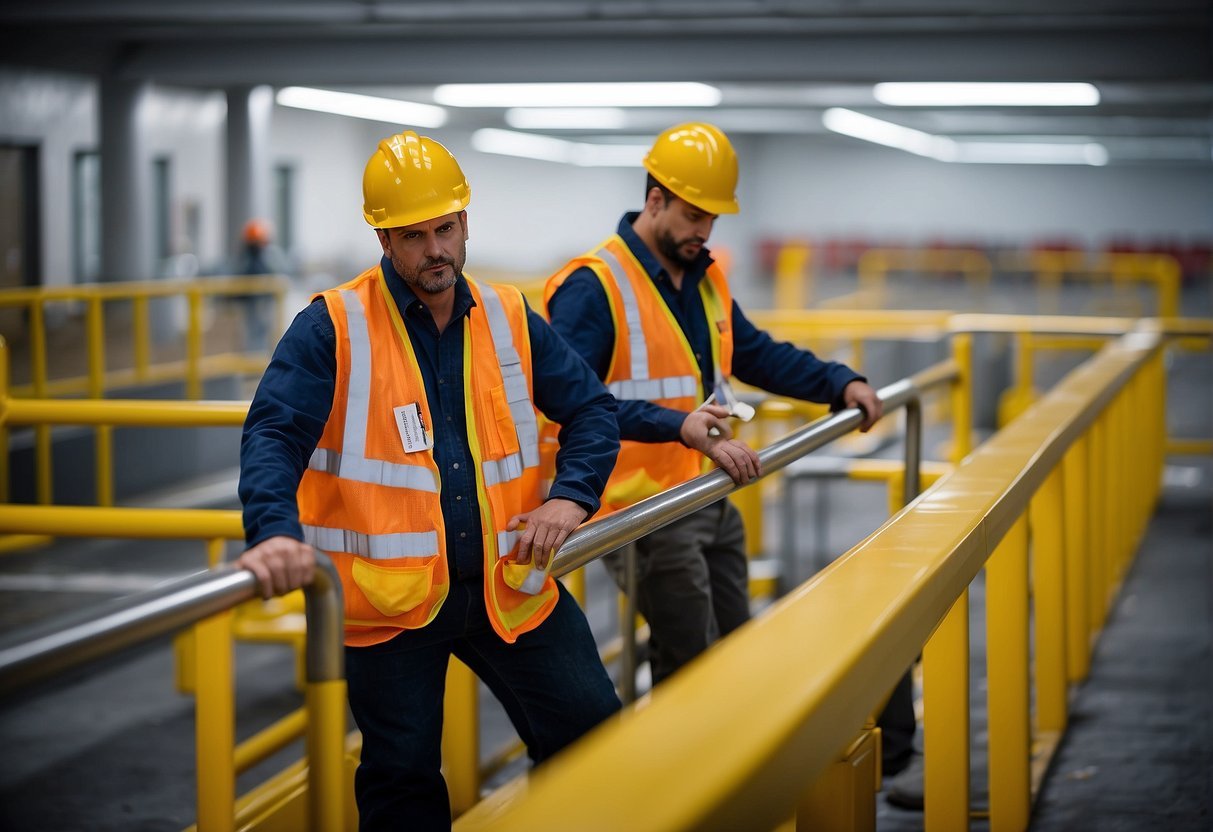أفكار لتعزيز السلامة في مكان العمل – الاستراتيجيات الأساسية لأصحاب العمل
Safety in the workplace is paramount for fostering a healthy and productive work environment. To keep employees safe, looking beyond the basic legal requirements and cultivating a safety-conscious culture is essential.
A proactive approach to safety helps avoid accidents and can also improve employee morale and productivity. By implementing strategic safety measures, your organization protects its staff and is committed to their well-being.

Creating a culture of safety starts with قيادة but requires the commitment of everyone in the organization. Regular risk assessments and safety policy reviews ensure safety procedures remain relevant and practical.
Training and education are crucial in keeping safety at the forefront of employees’ minds, while an investment in ergonomic improvements and well-maintained equipment reduces the risk of workplace injuries. Organizations should focus on responding to incidents and preventing them through continuous monitoring and inspections.
Ideas to Promote Safety in the Workplace – Key Takeaways
- A safety-first culture reduces risks and enhances employee well-being.
- Policies, procedures, and training are vital components of workplace safety.
- مستمر improvement in safety practices helps prevent workplace incidents.
Establishing a Safety Culture

Before a company can excel in operational performance, it’s essential to cultivate a robust safety culture. This includes adhering to safety regulations and engaging every level of the organization in a commitment to safety.
Engaging Leadership
Leadership sets the tone for a company’s safety culture. Your leadership should promote safety as a core value and demonstrate this commitment through actions and decisions. Through positive reinforcement and recognition of safe practices, leaders can drive home the importance of safety and boost morale within the team.
Encouraging Employee Involvement
Safety culture thrives when employees are active participants. Solicit feedback on safety practices and encourage reporting of hazards without fear of reprisal. Empowering your workforce to take ownership of their environment instils a sense of responsibility contributing to the safety culture.
Fostering Continuous Improvement
A static safety program is a risk; continuous improvement is the goal. Periodically review and update safety protocols to reflect new insights and technologies. Provide ongoing training that elevates the understanding of safety practices, motivating everyone to strive for a zero-incident workplace.
9 Essential Steps to Developing Safety Policies and Procedures

“Safety first” is more than just a catchy phrase; it’s a principle that safeguards businesses and employees alike. In developing workplace safety policies and procedures, your primary focus should be defining comprehensive safety requirements and creating effective reporting systems, ensuring a safer workplace for everyone involved.
Defining Safety Requirements
When it comes to workplace safety, defining safety requirements is the foundation. You should start by:
- Identifying potential hazards specific to your environment
- Outlining mandatory safety measures in response to these risks
- Establishing clear, written policies that comply with OSH guidelines and align with your company’s values can prevent workplace injuries, and maintaining a safe work environment is critical for business success.
Creating Reporting Systems
Creating a robust reporting system is vital for maintaining transparency and accountability:
- Develop a standardized incident report form
- This form should be easily accessible to all employees and provide clear instructions on documenting incidents.
- Designate a safety officer or committee responsible for handling reports
- Ensure there is a straightforward protocol for employees to follow when reporting safety issues or incidents.
Implementing these safety procedures and reporting systems protects employees and positively impacts business operations by minimizing risks and fostering a safety culture. Remember, a safer workplace leads to a more productive and engaged workforce.
Implementing Safety Training and Education
Nothing is more crucial than ensuring employees are well-educated and consistently trained regarding workplace safety. An environment prioritizing safety training and education can drastically reduce accidents and boost productivity.
Conducting Regular Trainings
Annual Refreshers: Employees should participate in regular training sessions to stay updated with the latest safety protocols, including fire safety, first aid، و ergonomics. This ensures that safety practices are not just learned but ingrained.
- Quarterly Workshops: Conduct workshops on specific safety areas, such as proper lifting techniques or emergency response drills.
- Monthly Meetings: Have short safety briefings to review safety guidelines and discuss any new concerns that may have arisen.
Providing Resources for Continuous Learning
Online Safety Courses: Offer access to a library of resources that cover a wide range of topics, allowing employees to learn at their own pace and on their schedule. Courses should be relevant and practical, including fire safety و first aid.
- Educational Materials: Distribute handbooks, guides, and checklists for employees to reference, ensuring safety information is always at hand.
- Learning Management Systems (LMS): Implement an LMS where training progress can be tracked and personalized to each employee’s role and responsibilities.
7 Essential Tips to Enhance Your Workplace Environment and Equipment
“An ounce of prevention is worth a pound of cure.” Keeping this in mind can save businesses much money and, quite possibly, lives. The following strategies focus on enhancing your workplace environment and its equipment, ensuring safety, and maintaining productivity.
Maintaining Machinery and Tools
Regular maintenance of machinery and tools is a crucial aspect of workplace safety. Keeping equipment in excellent working condition minimizes the risk of accidents. It improves the overall effectiveness of your work environment. For example, ensure that all machinery complies with safety standards and undergo documentation for regular checks.
- Daily Checklists: Develop a checklist for daily inspections of mechanical components and tools.
- Scheduled Maintenance: Adhere to the manufacturer’s schedule for servicing and maintain a log to track the history of repairs.
Utilizing Ergonomic Practices
Ergonomic practices are integral in creating a work environment conducive to employee health and productivity. Tailoring the workplace to the needs of your employees reduces the likelihood of injury from strain or overuse.
- Adjustable Stations: Equip workstations with adjustable chairs and desks to suit various employee needs.
- Proper Lifting Techniques: Implement training sessions that teach proper lifting techniques, thus avoiding back and joint injuries.
دمج labels and signs within the workplace ensures that employees are constantly reminded of safe practices. Clear and visible signage should direct workers on using equipment properly, mark marked areas, and provide instructions in emergencies. With thorough labels and signage, you inform and instil a culture of caution and care.
By honouring these two critical areas, maintaining equipment, and implementing ergonomic practices, you fortify your company’s most valuable asset—its people. Remember, your employees’ well-being reflects directly on your business’s productivity and longevity.
Monitoring, Inspection and Response
To ensure a safe working environment, diligent monitoring and inspection routines are critical, as is a swift response to incidents.
Conducting Regular Safety Inspections
Routine safety inspections are a cornerstone of any robust safety program. These inspections should be systematic, covering all potential hazards and ensuring all اجراءات السلامة are in place and functioning correctly.
- Checklist for Safety Inspections:
- Evaluate all equipment for proper operation.
- يضمن PPE availability and condition.
- Verify clear labelling and signage of hazardous areas.
Inspection Frequency: Depending on the workplace, some inspections might be daily, others monthly or annually.
Implementing Prompt Incident Response
When an incident occurs, the response must be prompt and effective to prevent further harm and to understand the root cause.
- Incident Response Steps:
- Secure the area to prevent additional hazards.
- Provide immediate aid and call for emergency services if necessary.
- Record and analyze the incident to improve prevention و بروتوكولات السلامة.
Training for Response: Employees should regularly train on how to respond to emergencies and incidents, ensuring readiness and competence.
Promoting Health and Wellness
In your efforts to create a safer work environment, understanding the pivotal role of health and wellness is essential. Proactive measures in these areas safeguard your workforce and contribute to your team’s overall productivity and morale.
Prioritizing Hygiene and Cleanliness
Maintaining high standards of hygiene and cleanliness is vital for preventing illnesses, such as كوفيد-19, in the workplace. Simple yet effective strategies include:
- Regular Sanitization: Equip common areas and workstations with disinfectants and encourage frequent use.
- Personal Hygiene: Ensure that handwashing facilities are well stocked and that hand sanitiser dispensers are readily available.
Providing clear guidance and access to resources enables employees to maintain a clean and hygienic environment, reducing the spread of pathogens and promoting overall wellness.
Encouraging Regular Breaks
To maximize productivity and mental acuity, encouraging regular breaks is crucial. Studies suggest that short, frequent breaks can rejuvenate focus and reduce strain. Implement policies that promote breaks by:
- Creating Relaxation Areas: Design spaces where employees can unwind and detach from work demands.
- Setting Break Alerts: Use systems or occupational clinician recommendations to remind your workforce to step away from their desks.
By allowing time for recovery throughout the day, you not only underpin safety and wellness but also foster a more engaged and effective workforce.







